photography by Rich Cox
[This 2011 Star Stratoliner Deluxe vs. 2011 Kawasaki Vulcan Vaquero Rider Comparison Test was originally published in the July 2011 issue of Rider magazine]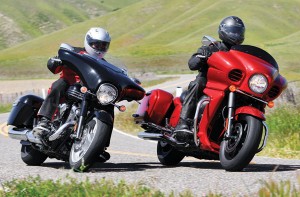
With chopper-mania fading farther and farther in the rearview mirror, the V-twin world has shifted its attention to baggers. As a touring magazine, we’re more concerned with functionality than fads, which is why you didn’t see a test of the Big Dog Bulldog “touring” bike in these pages but you have seen tests of the Harley-Davidson Street Glide, Victory Cross Country, Star Stratoliner Deluxe and Kawasaki Vulcan Vaquero, all very competent and impressive in their own ways. We conducted a Harley Street Glide and Victory Cross Country comparo in May 2010 (the Victory won), tested the Vaquero in our April issue and fully evaluated the Stratoliner Deluxe in the July 2011 issue. Time to find out how the newcomers compare back-to-back.
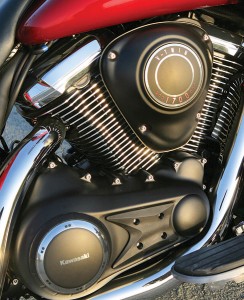
First, a refresher on the Vaquero. The newest member of Kawasaki’s Vulcan family, named after the Spanish word for cowboy, is positioned as a solo cruiser, but one equipped with features that make it ready for touring, even with a passenger. It’s powered by a 1,700cc, liquid-cooled, 52-degree V-twin with a single overhead cam and two valves per cylinder, mounted in a steel backbone dual-cradle frame with a steel swingarm. The Vaquero’s frame-mounted fairing is adapted from the Voyager, modified for the appropriate look with a short wind deflector, louvers instead of fog lamps and slim lowers. Hard, locking saddlebags are adapted from the Nomad, with smoother side-opening lids and color-matched trim pieces for an integrated appearance.
For this comparison test, I shanghaied my older brother, Paul. We’re both more than 6 feet tall and, after some masochistic exercise and fewer 12-ounce curls on my part, we weigh about 180 pounds apiece. Big Bro and I have heavy throttle hands, but having recently gone down in flames at traffic court trying to beat speeding tickets we got at the same time, we’ve been exercising restraint as of late.
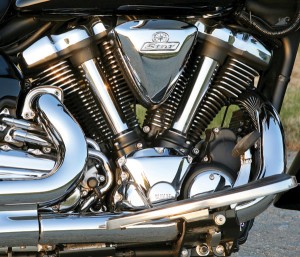
We headed north from San Buenaventura on U.S. 101 through coastal mountains made green by unusually heavy winter rains. At our first gas stop after more than 100 miles, Paul and photographer Rich Cox inquired why I was riding at or below the 65-mph speed limit. It wasn’t 5-0 phobia or an abiding desire to savor each moment of our Tuesday-morning ride. I was on the Star Stratoliner Deluxe, and riding above 65-70 mph took its toll. Helmet buffeting, turbulence in the cockpit and vibration through the seat and floorboards left me feeling shaken, not stirred. Even though the Stratoliner and Vaquero have similar shorty windscreens, the shapes of their fairings differ and the Stratoliner’s windscreen is located much closer to the rider. Thanks to well-integrated, wind-blocking fairing lowers, buffeting and turbulence weren’t a problem on the Vaquero, even at speeds up to 80 mph.
More miles, different bikes, back roads and floorboard-scraping photo passes. Seating comfort, it turned out, was a draw. Both the Star and the Kawasaki have dished saddles that rotate your hips and hunch your back, which becomes uncomfortable in less than an hour. Even though the Stratoliner’s 27.8-inch seat height is nearly an inch lower than the Vaquero’s 28.7 inches, taller riders will appreciate the Stratoliner’s more spacious cockpit, greater legroom and longer reach to its wide, plowlike handlebar. After back-to-back rides, our test passenger felt secure on the Star’s flat, well-padded pillion seat, but she complained about vibration and buffeting. The Vaquero’s sloping, tapered pillion seat required her to sit closer to the rider, but she felt more comfortable overall.
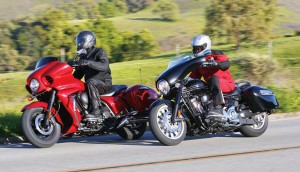
For many cruiser buyers, size matters, at least as far as the engine is concerned, and in this regard the Star outshines the Kawasaki. The Stratoliner Deluxe wins the displacement contest with 1,854cc (113 cubic inches) to the Vaquero’s 1,700cc (103.7 cubic inches). Even though their displacements differ by less than 10 percent, according to Jett Tuning’s Dynojet dynamometer the Stratoliner makes 12-29 percent more horsepower and torque between 1,900 rpm and 5,200 rpm (based on dyno readings from our 2009 Kawasaki Voyager test bike). The Stratoliner’s peak figures of 87.8 horsepower and 110.3 lb-ft of torque dwarf those of the Vaquero (72.3 horsepower and 93.4 lb-ft of torque). And fully fueled the Stratoliner is lighter, 805 pounds vs. 839 pounds for the Vaquero. Rolling on the Stratoliner’s throttle generated impressive thrust in almost any gear, whereas on the Vaquero a quick pass sometimes required a downshift. Given our more frequent shifts on the Vaquero, we appreciated its lighter clutch pull, smoother, quieter gear changes and overdrive sixth gear, something I tried in vain to find on the five-speed Stratoliner. More power usually translates into poorer gas mileage, but that didn’t happen. With lots of bike swapping over 700 miles and using the required premium fuel, we averaged 37.4 mpg on the Stratoliner and 35.8 mpg on the Vaquero. Despite its greater fuel efficiency, the Stratoliner’s 4.5-gallon tank limited range to 168 miles; the Vaquero’s 5.3-gallon tank yielded 190 miles.
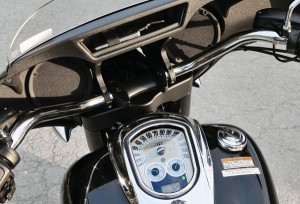
The Stratoliner’s power advantage was complemented by better handling and braking. It’s lighter, carries its weight lower and has a wider handlebar, all of which contributed to lower-effort steering at any speed. The Stratoliner’s four-piston mono-block front calipers provided more authoritative stopping power than the Vaquero’s two-piston pin-slide calipers. Even though the Stratoliner has more rear suspension travel (4.3 inches vs. 3.1 inches), the Vaquero offered a more comfortable and compliant ride. No adjustability is offered on the fork of either bike, but the Stratoliner can be adjusted for rear spring preload and the Vaquero’s rear shock can be adjusted for air pressure and rebound.
As baggers, the capacity and usefulness of the saddlebags is important. The hard, color-matched bags on both bikes are lockable, but the Stratoliner’s top-loading bags are easier to pack and root around in than the Vaquero’s side-loading bags, and they hold more stuff: 13.7 gallons vs. 10 gallons. The Stratoliner also has higher load capacity (408 pounds) than the Vaquero (391 pounds). The Vaquero has two small, locking storage pockets in the fairing, one of which includes a foam-rubber iPod holder. The only fairing storage on the Stratoliner is a small, central cavity designed to hold an iPod by means of an elastic band rather than a locking door.
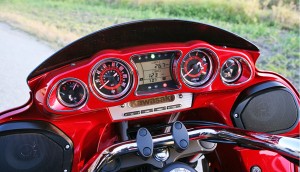
The Vaquero, largely adapted from the Vulcan Voyager full-dress tourer, offers much richer instrumentation and audio than the Stratoliner Deluxe. The inside of the Vaquero’s well-appointed fairing looks like the dashboard of a ’60s-era muscle car, with old-school gauges for fuel, speed, rpm and temp flanking a central LCD display and a retro-styled audio console. The gauges and LCD are within the rider’s line of sight, and the entire dash is color-matched to the bodywork. The audio system, with volume and tuning controls on the left switchgear, includes an AM/FM receiver, XM satellite radio tuner, full iPod integration and CB compatibility. Volume and clarity are good up to highway speeds, and accessory headsets are available from Kawasaki. Cruise control is also standard on the Vaquero, but isn’t available on the Stratoliner. Set within a tank-top console, the Stratoliner’s instruments are harder to read at a glance and contain less information. And the inside of its fairing, which is dark and looks unfinished, reminds me less of a dashboard and more of the inside of a trunk. Audio is limited to iPod compatibility, and though the speakers sound good, turbulence at speed diminishes clarity.
Been keeping score? If not, the Star Stratoliner Deluxe has the bigger, more powerful engine, better handling and braking, a more spacious cockpit, and larger, easier to use saddlebags. The Kawasaki Vaquero offers more wind protection, a smoother ride, better passenger accommodations, longer touring range, a feature-rich audio system and standard cruise control. The Stratoliner is raw and visceral, the Vaquero refined. Since taking the best aspects of both and creating a Starasaki Stratoquero isn’t an option, I’d put my hard-earned money toward a Vaquero. At $16,499, it’s nearly a grand cheaper than the Stratoliner Deluxe ($17,490), offering not only a better touring experience but more value. And it comes in red.
Base Price: $16,499
Warranty: 3 yrs., unltd. miles
Website: Kawasaki
Engine
Type: Liquid-cooled, transverse, 52-degree V-twin
Displacement: 1,700cc
Bore x Stroke: 102.0 x 104.0mm
Compression Ratio: 9.5:1
Valve Train: SOHC, 2 hydraulic valves per cyl.
Valve Adj. Interval: NA
Fuel Delivery: Digital EFI w/ 42mm throttle bodies x 2
Lubrication System: Wet sump, 5.3-qt. cap.
Transmission: 6-speed, hydraulically actuated wet clutch
Final Drive: Belt
Electrical
Ignition: TCBI w/ digital advance
Charging Output: 562 watts max
Battery: 12V 10AH
Chassis
Frame: Steel backbone w/ dual cradle & steel swingarm
Wheelbase: 65.6 in.
Rake/Trail: 30 degrees/7.0 in.
Seat Height: 28.7 in.
Suspension, Front: 45mm stanchions, no adj., 5.5-in. travel
Rear: Dual shocks, adj. for air pressure & rebound damping, 3.1-in. travel
Brakes, Front: Dual discs w/ 2-piston pin-slide calipers
Rear: Single disc w/ 2-piston pin-slide caliper
Wheels, Front: Cast, 3.50 x 16 in.
Rear: Cast, 5.50 x 16 in.
Tires, Front: 130/90-16
Rear: 170/70-16
Wet Weight: 839 lbs.
Load Capacity: 391 lbs.
GVWR: 1,230 lbs.
Performance
Fuel Capacity: 5.3 gals., last 1.3 gal. warning light on
MPG: 90 PON min. (high/avg/low) 41.4/35.8/28.6
Estimated Range: 190 miles
Indicated rpm at 60 mph: 2,100
Base Price: $17,490
Warranty: 1 yr., unltd. miles
Website: Star
Engine
Type: Air-cooled, transverse, 48-degree V-twin
Displacement: 1,854cc
Bore x Stroke: 100.0 x 118.0mm
Compression Ratio: 9.5:1
Valve Train: Pushrod OHV, 4 valves per cyl.
Valve Adj. Interval: 16,000 miles
Fuel Delivery: EFI w/ 43mm throttle bodies x 2 & EXUP
Lubrication System: Dry sump, 5.5-qt. cap.
Transmission: 5-speed, hydraulically actuated wet clutch
Final Drive: Belt
Electrical
Ignition: Digital TCI
Charging Output: 448 watts max.
Battery: 12V 12AH
Chassis
Frame: Tubular & box-section aluminum double cradle
Wheelbase: 67.5 in.
Rake/Trail: 31.3 degrees/6.0 in.
Seat Height: 27.8 in.
Suspension, Front: 46mm stanchions w/ 5.1-in. travel
Rear: Single shock, adj. for spring preload w/ 4.3-in. travel
Brakes, Front: Dual discs w/ opposed 4-piston mono-block calipers
Rear: Single disc w/ 2-piston pin-slide caliper
Wheels, Front: Cast, 4.50 x 18 in.
Rear: Cast, 5.50 x 17 in.
Tires, Front: 130/70-18
Rear: 190/60-17
Wet Weight: 805 lbs.
Load Capacity: 408 lbs.
GVWR: 1,213 lbs.
Performance
Fuel Capacity: 4.5 gals., last 0.9 gal. warning light on
MPG: 91 PON min. (high/avg/low) 40.4/37.4/34.1
Estimated Range: 168 miles
Indicated rpm at 60 mph: 2,300

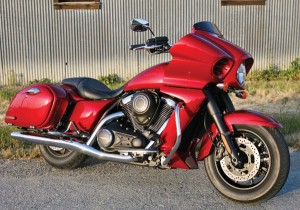
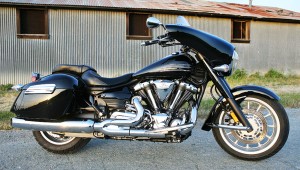







First of all, most of the pictures wouldn’t download so I missed them. Second, while it is nice and bright being that it is on the computer screen, I like to take my magazine out and read it while I float in the pool, take it with me in the saddlebags when I do a road trip or on the plane when flying. Bottom line is I much prefer print versions of books and magazines.